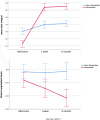The implementation of speckle tracking echocardiography for cardiac resynchronization therapy optimisation. A rotational myocardial mechanics interpretation
- PMID: 39617943
- PMCID: PMC11610125
- DOI: 10.1186/s44156-024-00062-z
The implementation of speckle tracking echocardiography for cardiac resynchronization therapy optimisation. A rotational myocardial mechanics interpretation
Abstract
Background: Cardiac resynchronization therapy (CRT) has an additive therapeutic influence on left ventricular function in heart failure patients, but the underlying mechanisms through which it works are not completely explained. Our aim was to further elucidate the role of this intervention via rotational mechanics using 2D speckle tracking echocardiography (2D-STE).
Results: We investigated 46 patients (65 ± 9 years) who received CRT. All enrolled patients were assessed on admission by 2D-STE and 6 min walk test (6 min WT) and followed in the outpatient device clinic by 2D-STE (at 1 week and 6 months post-implantation) and 6 min WT (at 6 months post-implantation). On their first appointment all biventricular systems were optimised by atrioventricular delay optimisation and by changing the temporal activation of ventricular electrodes aiming to reach the highest left ventricular effective stroke volume across all activation options. A new 2D-STE based index (twist integral) targeting to assess the rotational mechanics of the whole cardiac cycle was also measured to further explain the CRT response. Twenty-two (48%) patients were responders at 6-month follow-up and most of them had dilated cardiomyopathy. The commonest selected mode that was related with the greatest left ventricular performance response was the simultaneous activation of the 2 ventricular leads (39%). The strongest predictor of CRT response was the improvement of effective stroke volume between admission and first appointment at clinic, followed by the improvement of twist integral, the absence of coronary artery disease, and the improvement of peak systolic twist.
Conclusions: Additional CRT optimisation via changing the temporal activation of ventricular electrodes is beneficial for left ventricular performance in heart failure patients. The success of biventricular pacing may also be explained by the improvement of left ventricular rotational mechanics.
Keywords: Resynchronization therapy; Rotational mechanics; Speckle tracking echocardiography.
© 2024. The Author(s).
Conflict of interest statement
Declarations. Ethics approval and consent to partcipate: The work presented has been carried out in accordance with The Code of Ethics of the World Medical Association (Declaration of Helsinki) for experiments involving humans and informed and written consent was taken from all participants of the study. Competing interests: The authors declare no competing interests.
Figures



Similar articles
-
New approach for rotational dyssynchrony using three-dimensional speckle tracking echocardiography.Echocardiography. 2014 Apr;31(4):492-8. doi: 10.1111/echo.12406. Epub 2013 Oct 18. Echocardiography. 2014. PMID: 24138598
-
Left ventricular rotational dyssynchrony before cardiac resynchronization therapy: a step forward into ventricular mechanics.J Cardiovasc Med (Hagerstown). 2016 Jul;17(7):469-77. doi: 10.2459/JCM.0000000000000391. J Cardiovasc Med (Hagerstown). 2016. PMID: 27116377
-
Incremental Value of Speckle Tracking Echocardiography to Predict Cardiac Resynchronization Therapy (CRT) Responders.J Am Heart Assoc. 2016 Oct 19;5(10):e003882. doi: 10.1161/JAHA.116.003882. J Am Heart Assoc. 2016. PMID: 27792652 Free PMC article.
-
Speckle Tracking Echocardiography in Patients with Non-Ischemic Dilated Cardiomyopathy Who Undergo Cardiac Resynchronization Therapy: A Narrative Review.Diagnostics (Basel). 2024 Jun 3;14(11):1178. doi: 10.3390/diagnostics14111178. Diagnostics (Basel). 2024. PMID: 38893704 Free PMC article. Review.
-
Role of speckle tracking echocardiography beyond current guidelines in cardiac resynchronization therapy.Int J Cardiol. 2024 May 1;402:131885. doi: 10.1016/j.ijcard.2024.131885. Epub 2024 Feb 20. Int J Cardiol. 2024. PMID: 38382847 Review.
References
-
- Glikson M, Nielsen JC, Kronborg MB, Michowitz Y, Auricchio A, Barbash IM, Barrabés JA, Boriani G, Braunschweig F, Brignole M, Burri H, Coats A, Deharo JC, Delgado V, Diller GP, Israel CW, Keren A, Knops RE, Kotecha D, Leclercq C, Merkely B, Starck C, Thylén I, Tolosana JM. 2021 ESC guidelines on cardiac pacing and cardiac resynchronization therapy. Eur Heart J. 2021;42(35):3427–520. - PubMed
-
- Syed Yaseen Naqvi SY, Jawaid A, Goldenberg Ι, Kutyifa V. Non-response to cardiac resynchronization therapy. Curr Heart Fail Rep 2018;15(5):315–321. - PubMed
-
- Biswas M, Sudhakar S, Nanda N, Buckberg G, Pradhan M, Roomi AU, Gorissen W, Houle H. Two- and three-dimensional speckle tracking echocardiography: clinical applications and future directions. Echocardiography. 2013;30:88–105. - PubMed
-
- Mullens W, Tang W, Grimm R. Using echocardiography in cardiac resynchronization therapy. Am Heart J. 2007;154:1011–20. - PubMed
LinkOut - more resources
Full Text Sources
Research Materials

